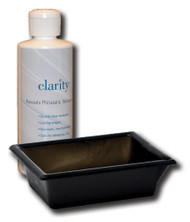Discovering the Hidden History: Using Watermark Fluid to Reveal Watermarks on Postage Stamps
Posted by Mystic Stamp Co. on 27th Jun 2024
Stamps are miniature windows to history, capturing significant moments and unique artistic expressions from around the world. For collectors, each stamp offers not only an aesthetic appeal but also a fascinating journey into the past. Among the myriad details that make stamps so intriguing are watermarks. These subtle, often hidden features can tell us a lot about a stamp’s origin and authenticity. Today, we'll explore how to use watermark fluid and a tray to reveal these hidden gems.
What Are Watermarks?
Watermarks are designs or patterns embedded into the paper during its production. Originally used as a security measure to prevent counterfeiting, watermarks have become an important feature for philatelists (stamp collectors). Identifying a watermark can help determine the authenticity, rarity, and value of a stamp, making it a crucial skill for any serious collector.
Tools You'll Need
To reveal watermarks, you'll need a few simple tools:
- Watermark Fluid: A special liquid designed to temporarily highlight watermarks without damaging the stamp.
- Watermark Tray: A small, shallow tray where you can safely apply the fluid to the stamp.
Step-by-Step Guide to Revealing Watermarks
- Prepare Your Workspace: Ensure you have a clean, well-lit area to work in. Place your watermark tray on a flat surface to prevent spills.
- Handle with Care: Stamps are delicate, so handle them with clean hands or use stamp tongs to avoid oils and dirt.
- Place the Stamp in the Tray: Lay the stamp face down in the watermark tray. This position ensures the watermark will be clearly visible when the fluid is applied.
- Apply the Watermark Fluid: Carefully apply a few drops of watermark fluid to the back of the stamp. The fluid spreads quickly, so you only need a small amount to cover the entire surface.
- Observe the Watermark: Within a few seconds, the watermark should start to appear. The fluid highlights the differences in the paper thickness, making the watermark visible. Look for any patterns, letters, or symbols that indicate the watermark's presence.
- Let It Dry: Once you've identified the watermark, gently remove the stamp from the tray and let it air dry. The fluid evaporates quickly, leaving no residue or damage.
Tips for Success
- Use a Magnifying Glass: A magnifying glass can help you see finer details of the watermark more clearly.
- Stay Organized: Keep a record of the watermarks you find, along with details about each stamp. This information can be invaluable for your collection’s provenance and value assessment.
- Be Patient: Some watermarks can be faint or complex. If you don’t see it right away, give it a few more seconds and try adjusting the angle of light.
Why Watermarks Matter
Identifying watermarks can significantly impact the classification and valuation of your stamps. For example, two seemingly identical stamps may have different watermarks, indicating different printings or issues. This distinction can mean the difference between a common stamp and a rare, valuable piece.
Conclusion
Using watermark fluid and a tray to reveal watermarks is a simple yet essential technique for stamp collectors. It not only helps in authenticating and valuing stamps but also adds an exciting layer of discovery to your collecting experience. So next time you come across an intriguing stamp, take a closer look—you might uncover a hidden story waiting to be told.

